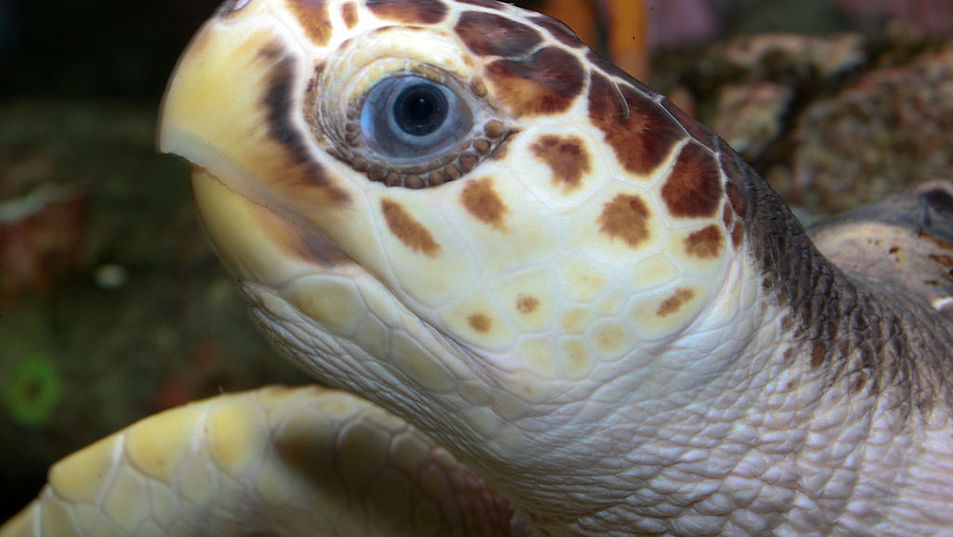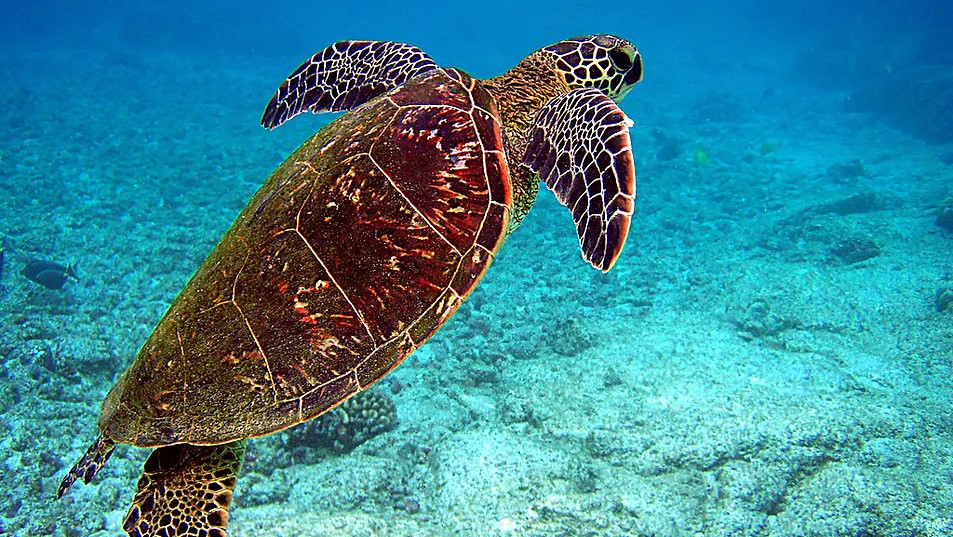
SEA TURTLE SPECIES
A variety of endangered sea turtles find their way onto Delaware beaches each and every year. Recently, a green sea turtle had decided to nest at Cape Henlopen State Park, which was the first recorded nesting in the state.
MERR was instrumental in the care for the eggs.
_.jpeg)
Loggerhead Turtle
(Caretta caretta)
Anatomy:
-
Appearance: Head is very large with heavy strong jaws. Carapace is bony without ridges and has large, non-overlapping, rough scutes (scales) present with 5 lateral scute. Carapace is heart shaped. Front flippers are short and thick with 2 claws, while the rear flippers can have 2 or 3 claws. Carapace is a reddish-brown with a yellowish-brown plastron. Hatchlings have a dark-brown carapace with flippers pale brown on margins.
-
Hatchling size: 1.8in 0.7oz
-
Adult size: 155-375lbs. 2.5-3.5ft
Nesting:
-
Nest every 2-4 years; lay 3-6 nests per season; 100-126 eggs per nest; eggs incubate for 60 days
Fun Facts:
-
Metabolic rate is highly sensitive to sea temperature. Between 55-59 degrees they become lethargic and cold-stunned. Loggerheads migrate to avoid cold-stunning
-
Female on female aggression is common in Loggerheads, though rare in most other marine vertebrates.
-
Loggerheads have extremely strong jaws which they use to break open shells of prey
-
A female Loggerhead will travel thousands of miles to lay eggs on the same beach she hatched from
-
The Loggerhead species has been on earth for 110 million years!
Loggerhead Turtle
(Caretta caretta)
Location:
-
Prefer to feed in coastal bays and estuaries, as well as in the shallow water along the continental shelves of the Atlantic, Pacific and Indian Oceans
Status:
-
Endangered in U.S.
Population:
-
40,000-50,000 nesting females (estimate)
Threats:
-
Destruction of nesting habitat due to costal development
-
Predation of nests
-
Human disturbance
-
Pollution
Diet:
-
Horseshoe crabs, clams, mussels, other invertebrates
.jpeg)
Leatherback Sea Turtle
(Dermochelys coriacea)
Anatomy:
-
Appearance: Head has a deeply notched upper jaw with 2 cusps. The leatherback is the only sea turtle that lacks a hard shell. Its carapace is large, elongated and flexible with 7 distinct ridges running the length of the animal. Composed of a layer of thin, tough, rubbery skin, strengthened by thousands of tiny bone plates, the carapace does not have scales, except in hatchlings. All flippers are without claws. The carapace is dark grey or black with white or pale spots, while the plastron is whitish to black and marked by 5 ridges. Hatchlings have white blotches on carapace.
-
Hatchling size: 1.5oz
-
Adult size: 660-1,100lbs. 4-6ft
Nesting:
-
Nest every 2-3 years; 80 fertilized and 30 unfertilized eggs in each nest; eggs incubate for 65 days; may change nesting beaches unlike other sea turtles
Fun Facts:
-
Leatherbacks undertake the longest migrations between breeding and feeding areas of any sea turtle, averaging 3,700 miles each way.
-
Unlike their reptilian relatives, leatherbacks are able to maintain warm body temperatures in cold water by using a unique set of adaptations that allows them to both generate and retain body heat.
Leatherback Sea Turtle
(Dermochelys coriacea)
-
Leatherbacks can dive to depths of 4,200 feet—deeper than any other turtle—and can stay down for up to 85 minutes.
-
Leatherbacks are the largest turtles on earth
-
While all other sea turtles have hard, bony shells, the inky-blue carapace of the leatherback is somewhat flexible and almost rubbery to the touch.
-
The only reptile known to remain active in temperatures below 40 degrees.
Location:
-
Primarily found in the open ocean, as far north as Alaska and as far south as the southern tip of Africa.
Status:
-
Endangered in U.S.
Population:
-
34,000-36,000 nesting females (estimate)
Threats:
-
Incidental catch in commercial fishing
-
Pollution
-
Human disturbance
Diet:
-
Almost exclusively jellyfish

Green Sea Turtle
(Chelonia mydas)
Anatomy:
-
Appearance: They are easily distinguished from other sea turtles because they have a single pair of prefrontal scales (scales in front of its eyes), rather than two pairs as found on other sea turtles. Head is small and blunt with a serrated jaw. Carapace is bony without ridges and has large, non-overlapping, scutes (scales) present with only 4 lateral scutes. Body is nearly oval and is more depressed (flattened) compared to Pacific green turtles. All flippers have 1 visible claw. The carapace color varies from pale to very dark green and plain to very brilliant yellow, brown and green tones with radiating stripes. The plastron varies from white, dirty white or yellowish in the Atlantic populations to dark grey-bluish-green in the Pacific populations. Hatchlings are dark-brown or nearly black with a white underneath and white flipper margins.
-
Hatchling size: 0.85oz
-
Adult size: 240-420lbs. 3-4ft
Nesting:
-
Nest every two years; 3-5 times per season; average of 115 eggs per nest; eggs incubate for 60 days
Green Sea Turtle
(Chelonia mydas)
Fun Facts:
-
During the night while sleeping and to protect themselves from potential predators, the adults wedge themselves under rocks below the surface and under ledges in reefs and coastal rocks. Many green sea turtles have been observed in returning to the same sleeping location night after night.
-
Juvenile Green Turtles are carnivorous, but with age they become herbivorous
-
Largest hard-shelled turtle
-
Scientists believe their plant based diet is what gives them their green color
Location:
-
Found in all temperate and tropical waters throughout the world.
Status:
-
Endangered in U.S.
Population:
-
85,000-90,000 nesting females (estimate)
Threats:
-
Commercial harvest for eggs, meat, and leather
-
Incidental catch in commercial shrimping
Diet:
-
Juvenile: Worms, young crustaceans, and aquatic insects
-
Adulthood: Sea grass and algae
.jpeg)
Kemps' Ridley Turtle
(Lepidochelys kempii)
Anatomy:
-
Appearance: Triangular and moderate sized head; bony carapace without ridges and large, non-overlapping scutes, five lateral scutes and very rounded; front flippers have one claw whereas the back flippers can have 1-2 claws; adults have dark gray green carapace with a white plastron; hatchlings are black in color
-
Hatchling size: 0.6oz
-
Adult size: 70-108lbs. 2-3ft
Nesting:
-
Nest every 1-3 years; 2-3 times each season; lay an average of 110 eggs in each nest; eggs incubate for 55 days
Fun Facts:
-
They are the only species that nests mostly during the day and also nest in mass just like their family member the olive ridley.
-
The world’s most endangered sea turtle
Kemps' Ridley Turtle
(Lepidochelys kempii)
Location:
-
Juveniles can be found along the east coast of the U.S., in tropical and temperate coastal areas; adults stay in Gulf of Mexico mostly; found in shallow areas with sandy or muddy bottoms
Status:
-
Endangered in U.S.
Population:
-
7,000-9,000 nesting females (estimate)
Threats:
-
Human collection of eggs and meat
-
Incidental catching in commercial shrimping
Diet:
-
Crabs, clams, mussels, shrimp, fish, sea urchins, squid and jellyfish

